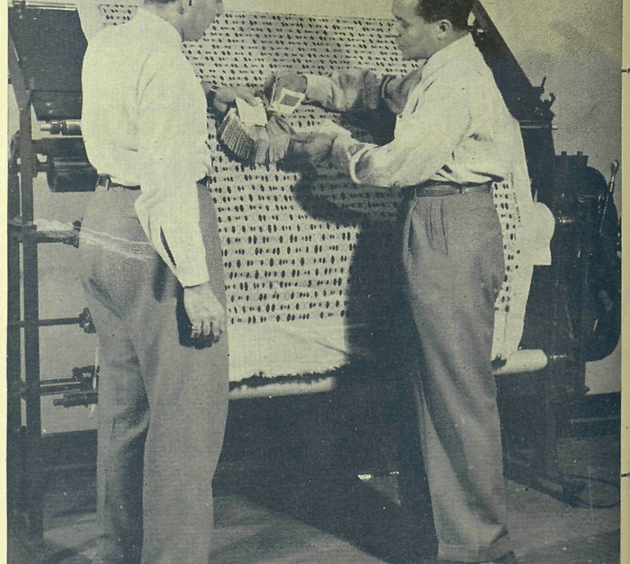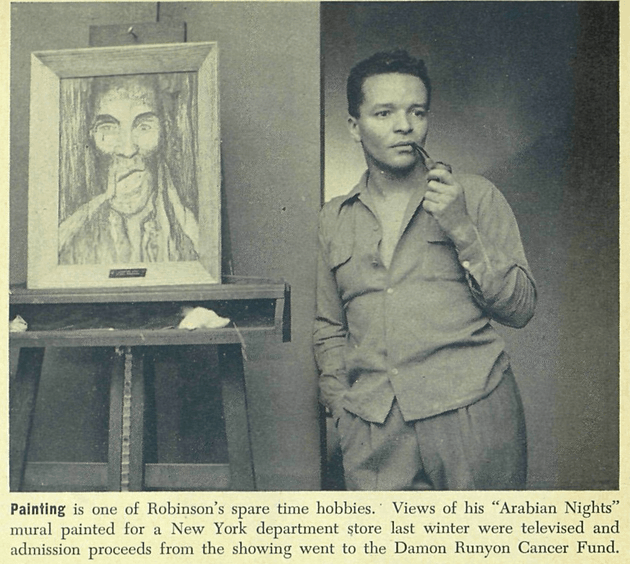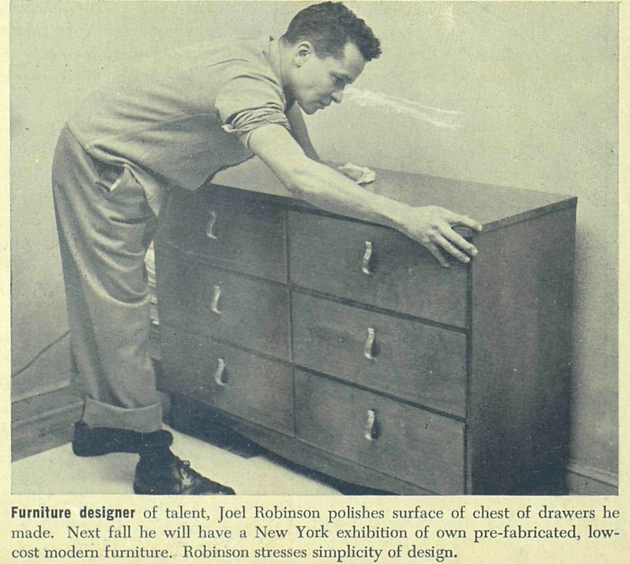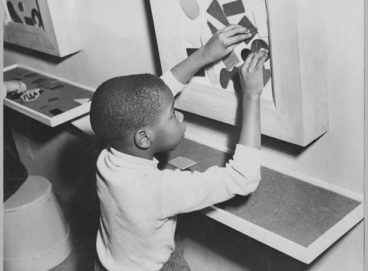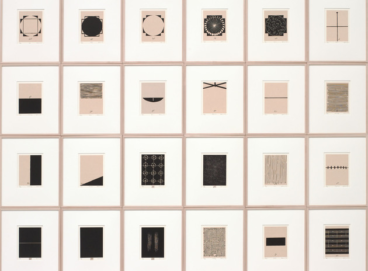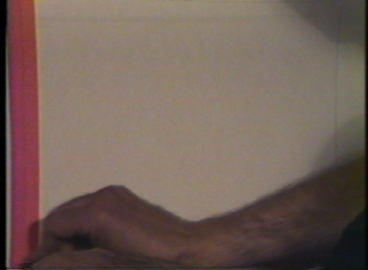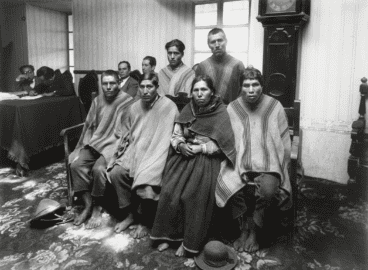American textile designer Joel Robinson remains an enigmatic figure despite his inclusion in MoMA’s collection. In 2017, a chance research encounter by the author and colleagues at a New York textile gallery yielded a surprising fact: Robinson is the first known black designer to be exhibited at a MoMA ‘Good Design’ exhibition and the first to enter the Architecture & Design collection. Though heralded at the time for his “strikingly original” textile designs, much about his life since his inclusion in the 1951, 1952, and 1955 ‘Good Design’ exhibitions remains unknown.

MoMA’s second annual Good Design exhibition, which opened on November 27, 1951, featured 335 objects brought together in the Museum’s first floor galleries in a display designed by the Danish designer Finn Juhl (1912–1989). Among the new-to-the-market home furnishings on view were seventy-plus fabrics, many hung at the edges of the room to emphasize their collective volume, which together revealed a range of surprising patterns and materials.
Four printed textiles manufactured by L. Anton Maix, Inc., were included in the selection, each produced using the firm’s signature Belgian linen and retailing at Bloomingdale’s for nine dollars per yard.1Edgar Kaufmann, Jr., Good Design November 22, 1950 to January 28, 1951: An Exhibition of Home Furnishings, (New York: The Museum of Modern Art, 1950). A press release jointly issued by MoMA and the Chicago Merchandise Mart earlier that year singled out one particular Maix fabric, calling it a “fascinating essay in graded proportions, printed in charcoal and black on white.”2The Museum of Modern Art and The Merchandise Mart, “June 1951 ‘Good Design’ Exhibition to Open During First Market Week,” news release, June 22, 1951, https://www.moma.org/momaorg/shared/pdfs/docs/pressarchives/1522/releases/MOMA1951_0040.pdf. That textile, designed by the New York designer Joel Robinson (c. 1923 – ?) and called Ovals, achieved its dazzling effect through the repetition of elliptical forms, stacked one on top of the other, that recall the pattern of an architect’s stencil. Another version of Robinson’s textile, called Ovals # 1, made repeat appearances in the 1952 and 1955 editions of Good Design, a rare feat reserved only for the best-known designers of the day.

Despite these early signs of success, Robinson is today a figure lost to history, a fact this article aims to correct. Thanks to excellent research from colleagues at the Cora Ginsburg Gallery in New York, we now know that Robinson was the first black designer to be exhibited in a MoMA Good Design exhibition series. He is also the first to enter the Architecture and Design collection.3Charles Harrison was previously considered the first black designer to enter the collection when MoMA acquired the View-Master in 2016. An example of Ovals #1 by Joel Robinson was formally entered into the collection in 1975, with subsequent examples of Ovals, Ovals #1, and Ovals #2 added in 2017. Though heralded at the time for his “strikingly original”4“Fabric Designer,” Ebony vol. 7 no. 7 (May 1952): 113. textile designs, much about his life since his inclusion in the 1951, 1952, and 1955 Good Design exhibitions remains unknown. Robinson’s story, in many ways, mirrors the story of so many others featured in the Good Design series, whose promising careers never gained the traction that such recognition might reward. But fighting to make it in the “lily-white field”5Ibid., 117. of design as a black man from New York City must have carried with it a unique set of challenges, necessitating a consistent and sustained battle against the prevailing forces of institutional racism. This article therefore attempts to situate artist-designer Joel Robinson’s career in the larger context of MoMA’s early 1950s Good Design initiatives, just before the outset of the Civil Rights era, and looks at how African American media outlets like Ebony magazine created a venue for the celebration and expression of black excellence. This article serves as a beginning, not an end; a way to assess the institutional histories that so readily enshrine the careers of some but not others; and the ways that such histories require near-constant revision.
—
In the May 1952 issue of Ebony magazine, a multipage story on Joel Robinson’s breakout career called him “one of the most promising newcomers in the highly-competitive field of fabric design.”6Ibid., 113. According to editors, the “youthful, multi-talented New Yorker” was the “[f]irst Negro to crack the fabric design field and only Negro ever to win Good Design Awards.”7Ibid. Note that the MoMA Good Design exhibitions were not awards, despite the confusion in Ebony, but rather represented a range of items chosen by the selection committee. At twenty-nine, the “ex-bellhop” had just developed a new “kaleidoscopic” fabric-printing process, “which some claim will revolutionize the textile industry.”8Ibid. A profile portrait of the handsome designer, with his Ovals fabric design in the background, appears at the top of the article, while his sister, Mrs. Callie Middleton, models an elegant Ovals dress designed by the pair in an image on the same page.

Subsequent pages reveal his industriousness, placing him in the studio designing new fabrics; in the factory selecting color swatches with L. Anton Maix, his manufacturer; at the easel, tobacco pipe in hand, with one of his paintings; and at home moving a chest of drawers of his own design into place. Robinson’s multifaceted career is further described, indicating that he “has written and illustrated a children’s book” and is “an advertising layout specialist.”9Ibid.




Elsewhere, the reader learns that Robinson turned to architecture as a course of study at New York University and then at Cooper Union, but “discovered that no New York firm was interested in hiring a Negro architect. Instead he became a caddy master, bartender, bellhop—anything which would earn him a living during the long wait between the few small jobs in commercial art which came his way.”10Ibid., 117. Eventually, Robinson made a name for himself at Hartwell Ayles’s advertising agency, designing a series of successful 1940s campaigns for Steuben Glass, “twice selected among the 100 best ads of the year,” according to the article. It was this work that brought him to the attention of Maix, who in 1948, had left Knoll Associates, Inc., to set up his own printed textiles firm.11Despite his success working with Maix, Robinson held down a day job at William Douglas McAdams at the time the article was written. William Douglas McAdams is the pharmaceutical advertising agency that would come under the ownership of the Sackler brothers, infamous today for their work in marketing the dangerous opioid painkiller OxyContin. Robinson’s success in developing the Ovals fabrics with Maix, who at the time worked with prominent designers like Serge Chermayeff (1900–1996), Paul Rand (1914–1996), and Alvin Lustig (1915–1955),12Serge Ivan Chermayeff. Textile, Inside-Outside. 1950–53. Linen, 52 1/4 x 34 1/2″ (132.7 x 87.6 cm). Mfr.: L. Anton Maix, Inc. American Textile History Museum Collection. Gift of Giles Kotcher; 2016-35-102. https://collection.cooperhewitt.org/objects/1108711 led to the introduction of three other patterns, including Glen Plaid, Honeycomb, and Roman Candles.13Roman Candles was recently acquired into the MoMA collection, along with examples of Ovals and Ovals #1. According to the article, Robinson’s professional pursuits left little time for leisure or for love: “The serious-minded New Yorker takes only one night off a week from his work and that is spent in a session on painting with other young artists.” Still, the article concludes, Robinson campaigned “vigorously to get other Negro artists accepted into the fabric industry.”14“Fabric Designer,” 117.
The forthright and upbeat portrayal of a designer on the rise was by no means a rarity in the pages of Ebony, which along with its sister publication Jet became one of the most potent crusaders for racial equality in postwar America by publishing stories of successful black Americans succeeding in the face of incredible odds. Founded in 1945 by the black entrepreneur John H. Johnson, Ebony appealed to the growing African American middle class by challenging “the negative depictions of African Americans all too pervasive in the larger society.”15June O. Patton, “Remembering John H. Johnson, 1918–2005,” Journal of African American History90, no. 4 (Autumn 2005): 456. Ebony, a monthly magazine, and Jet, a weekly, “debunked these stereotypes by presenting more accurate accounts of black life, history, and culture; and they provided African Americans with more positive self-images.”16Ibid. A regular feature of Ebony entitled “Speaking of People” was devoted to everyday black Americans doing everyday work. In the same issue in which Robinson appeared, a “Big League Baseball Player,” a “Rio Telephone Executive,” a “Girl Auto Mechanic,” and a “74-Year-Old Skater” were all highlighted, their stories all the more extraordinary given America’s history of racial subjugation.17“Speaking of People,” Ebony Vol. 7 no. 7 (May 1952): 4–5. Other articles in the May 1952 issue similarly celebrated the success of black people around the world, including a feature on “Foreign Negro Authors” and another which pondered, “Can Negro Athletes Stop the Russians?”. A story on the singer Dorothy Dandridge proclaimed her “America’s hottest singer,” suggesting that the “slim, sensuous” chanteuse “has captured Broadway audiences as no vocalist in recent years with her sultry singing.”18“Don’t Be Afraid of Sex Appeal,” ibid., 24.

Reading the letters to the editor over the course of multiple issues, it is clear that Ebony had a sizable footprint in the larger culture, reaching audiences as far afield as Australia, Europe, Africa, and parts of Asia. In the May 1952 issue, one reader from Hong Kong wrote: “Your magazine has opened my mind to a lot of things that I was hitherto ignorant about and this makes me all the more curious to get in touch with some of you at least so that I can get to know your people better. I have always been a keen admirer of your race, but I have had very little occasion to meet them or come in close contact with them personally. Here’s wishing Ebony every success and a greater circulation, particularly in Asia.”19A. Dasen, letter to the editor, ibid., 9.
Other letters to the editor wondered about the use of the term “Negro”; relayed their experiences as a white person in an almost entirely black neighborhood (“intelligent whites do not flee a neighborhood—they are driven!”20Philip H. Vision, letter to the editor, Ebony vol. 8, no. 1 (November 1952): 6.); or, as was the case with one reader from Liberia, critiqued a November 1952 article on African natives, saying, “It bewilders your readers to see that Ebony has joined the crusade in the continuous cataloguing of Africa as the ‘Dark Continent.’”21Nathaniel C. Eastman, letter to the Editor, Ebony vol. 8, no. 3 (January 1953): 13-14. Poring over hundreds of letters in the pages of the magazine from the early 1950s reveals an intense devotion to a publication that sat at the crossroads between black culture and white-dominated society. “I am a Negro soldier, at the present time in the hospital,” wrote one reader in the July 1952 issue. He continued: “Being the only Negro in this particular ward, I wondered what would happen when the other soldiers asked to read my magazines and I offered them Ebony. Well, the results were surprising to me because every man in this ward has read this month’s issue of Ebony (April) and a couple of fellows started talking about how good Duke Ellington, Sarah Vaughan and others were when they appeared in Nashville, Tenn. Keep up the good work.”22Sgt. Maurice L. Nelson, letter to the Editor, Ebony vol. 7, no. 9 (July 1952): 9. In reviewing many of these letters, it is clear that readers saw the value in the Ebony brand of black excellence, and felt that the continual pursuit of stories that elevated the status and position of African Americans in society was in general a positive effort.
The reporting in Ebony often tackled hard issues (“South Weaves New Pattern of Violence,” “Why Negroes Don’t Adopt Children,” and “Baha’i Faith: Only Church in the World That Does Not Discriminate”), but also found room for lighter fare, publishing features on black celebrities, marriageable mates, and quests for love. A January 1952 article entitled “The Men in My Life” chronicled the actress Ethel Waters’s sexual exploits, detailing with lurid interest her clashes with abusive men. Men were frequently depicted as the head of the household, with women positioned in roles of subservience, mirroring the themes of male dominance at play in the burgeoning white American middle class. An October 1952 photo feature entitled “Wealthy Bachelors” introduced the selection of eligible singles thusly: “Were these nuptial-shy gentlemen to advertise for mates (an old and accepted practice in India) they would ask for applicants between the ages of 22–38; attractive and ‘well distributed,’ able cooks, housekeepers, hostesses and lovers; in colors ranging from light to luscious brown.”23“Wealthy Bachelors,” Ebony vol. 7, no. 12 (October 1952): 31. The article introduces us to Joel Robinson yet again, pegging him as a “the 29-year old celebrated New Yorker who has sideline careers as advertising artist, technical illustrator and furniture creator”.

His enviable ten thousand dollars per year salary (nearly one hundred thousand in today’s dollars) made him a desirable catch, but as the article makes plain, he “has no steady girlfriend, insists he is ‘too busy to fall in love.’”24Ibid. A letter to the editor from Mrs. Dolores Robinson in July 1954 indicates that Joel Robinson’s exposure in the magazine did in effect put the fabric designer’s bachelorhood to an end: “It’s because of your wonderful magazine Ebony that I am one of the most happy girls alive. In the May 1952 issue of Ebony, you had an article on Joel Robinson, a fabric designer—and that’s how it all started . . . We have been married now since October and I know if I hadn’t seen him first in Ebony all this happiness would not be mine.”25Dolores Robinson, letter to the editor,” Ebony vol. 9, no. 9 (July 1954): 6.
That Joel Robinson appeared on numerous occasions in the pages of any mainstream magazine of the day would be extraordinary. But in the pages of Ebony, it felt just right, the kind of everyday African American that founder John H. Johnson sought to highlight over and over again. “Johnson wanted to show people on both sides of the color line a simple truth: black is beautiful, too.”26Don Terry, “An Icon Fades,” Columbia Journalism Review. Accessed May 1, 2019: https://archives.cjr.org/feature/aniconfades_1.php. Robinson, along with countless others who appeared in the pages of Johnson’s magazines, was the personification of blackness made excellent, a person succeeding against incredible odds to do things that a generation previously might have been possible only in the deepest realms of the imagination.
—
Whereas Robinson’s identity as an African American man was centered in black media outlets like Ebony, it was entirely absent from any records related to his selection for the Good Design exhibitions. In many cases, reference to the fabric is made in connection with Maix, his manufacturer, who by the early 1950s was already a known entity in the American design industry. Letters from Good Design director Edgar Kaufmann, Jr., were always directed to Maix, requesting samples of the latest designs to be submitted for consideration and inclusion in the exhibitions.27The Museum of Modern Art Exhibition Records, 494.2. The Museum of Modern Art Archives, New York. Only designers directly involved in the manufacture of their own wares, or those who had achieved a level of fame, such as Charles (1907–1978) and Ray Eames (1912–1988), and Eero Saarinen (1910–1961), seemed to be directly in touch with Kaufmann as he was researching the current marketplace. Yet the dominating influence of the commercial interests involved in the exhibitions were part of the point.
Developed in collaboration with the Chicago Merchandise Mart, then an important wholesale center for retailers across the United States, and The Museum of Modern Art, the Good Design exhibition program was devoted to surveying the contemporary American design marketplace. A scion of a Pittsburgh, Pennsylvania, retailing empire and a MoMA curator since 1940, Kaufmann saw the Good Design exhibitions as a way to connect museum-going audiences with the latest examples of contemporary furniture, fabrics, lighting, home appliances, and other household goods. “The Good Design exhibitions mean different things to a great many people. . . . To me, these exhibitions are an instrument of knowledge, a job of research undertaken twice a year to find out what the relationship is, that season, between the home furnishings trades and the progressive designers,” Kaufmann wrote in the March 1951 issue of Interiors magazine.28Edgar Kaufmann Jr. and Finn Juhl, “Good Design ’51 as Seen by Its Director and by Its Designer,” Interiors vol. 110, no. 8 (March 1951): 100. A Good Design exhibition committee, comprised of Kaufmann and two other members chosen from a rotating cast of design experts of the day, met twice a year in Chicago, once in January and once in June, to make their selections. The criteria for branding objects with the Good Design seal of approval was generally subject to the individual jury’s discretion, but as a MoMA press release from 1950 makes clear, all selected designs had to be “intended for present-day life, in regard to usefulness, to production methods and materials and to the progressive taste of the day.”29The Museum of Modern Art, “First Showing of Good Design in New York,” news release, November 1950, https://www.moma.org/momaorg/shared/pdfs/docs/pressarchives/1472/releases/MOMA195000811950-11-16_501116-70.pdf. The committee’s selections were first shown in an exhibition in Chicago at “the Mart,” an edited assortment of which was later brought to MoMA in November to coincide with the holiday shopping season.
“Good Design can sell merchandise because the public is naturally receptive toward new and progressive ideas, especially if these are endorsed by people with no axes to grind,” Kaufmann wrote in 1951. “Good Design serves the public as a buying guide, it serves the designers as an index of current achievements, it serves the manufacturer as a focus of design trends, it serves the retailer as a basis for securing an additional market.”30Kaufmann and Juhl, “Good Design ’51,” 100. Kaufmann believed that Good Design was a catalyst for wider acceptance of modern design in America, a vessel that embodied the principles of modernist design—form follows function, being one—that, from the very beginning, The Museum of Modern Art sought to embed in public discourse. For five seasons, the Good Design exhibitions were a marked success, positioning MoMA as a leading voice in the realm of contemporary design.
Claiming the endorsement of the committee was a boon for American manufacturers and retailers, who prominently utilized the name in advertisements and store displays, sometimes, as Ebony did, erroneously designating products as “a Good Design award winner.” An advertisement for L. Anton Maix, Inc., fabrics did just that, celebrating the firm’s “Good Design Awards” in the December 1951 issue of Interiors magazine.

Robinson’s Ovals textile serves as the backdrop for the ad, which celebrates the work of five American designers whose work was identified by the committee. Such recognition helped working designers as well, many of whom were looking to break into the burgeoning post–World War II American market. Though largely limited to work produced by Americans, the exhibition included a number of international designers, including Danes Hans Wegner (1914–2007) and Finn Juhl, who obtained international recognition for their involvement or inclusion in these shows and would go on to have highly successful careers. Robinson never raised his profile to the level of many fellow designers who participated in the exhibitions, despite repeated signs of his breakout talent.
—
In 2017, William DeGregorio, a researcher at Cora Ginsburg Gallery, alerted the Museum to the existence of several fabrics that had been designed by Joel Robinson, a designer whose textiles were included in the MoMA Good Design exhibitions. The Museum already held a length of his Ovals #1 textile, which was added to the study collection in 1975, but about which the current generation of curators knew very little. Robinson’s story is not unlike that of many other artists and designers whose work comprises MoMA’s collection; countless stories remain untold or unknown. This chance discovery was an opportunity to expand understanding of the collection and engage new avenues for research, especially as the Museum prepares to close for several months to reinstall the permanent collection with a more expansive view of modern art.
Information on Robinson’s life is thus far limited, but what is known reveals a man who continually tested the limits of the color barrier in his work as a creative professional. After leaving school in the early 1940s having studied architecture—it is not known yet whether he graduated from either NYU or Cooper Union—he did a variety of jobs to make a living until he found design work as an art director for the magazine of the National Aeronautic Association. After working on advertising and illustration projects during the war, according to Ebony, he moved on to a series of ad agencies, including Hartwell Ayles and then William Douglas McAdams. According to DeGregorio, he designed sheet music covers in the 1940s, including for “A Gal in Calico” from 1946, and he “also probably designed the spare, elegant look of the short-lived progressive literary journal The Contemporary Reader (1953–55), edited by Benjamin Brown, former head of The Harlem Quarterly, and staffed by a volunteer corps of liberal-minded, mainly African American intellectuals.”31Titi Halle and Cora Ginsburg LLC, “Ovals, Ovals #1, and Ovals #2: Printed Linens by A. Joel Robinson for L. Anton Maix Fabrics,” in A Catalogue of 20th Century Costume & Textiles 2018 (New York: Cora Ginsburg LLC, 2018), 12–13, https://coraginsburg.com/catalogues/2018/CoraGinsburg-Modern-2018.pdf.

In October 1953, Robinson married and settled in Brooklyn with his new wife Dolores. In February 1954, Jet announced Robinson’s promotion from creative art director to executive vice president of the David D. Polon Advertising Agency, a New York firm that specialized in packaging design.


According to an announcement about the promotion in the February 22, 1954, issue of Broadcasting Telecasting, “He will direct an expanded department for new client services for product design, packaging, promotion, and direct mail.”32“People,” Broadcasting Telecasting vol. 46, no. 8 (February 22, 1954): 83, https://archive.org/details/broadcastingtele46unse/pa A March 9, 1985, issue of New York Amsterdam News, a newspaper with a primarily African American readership, mentions Robinson’s inclusion in an exhibition of contemporary black artists at the Great Neck Library in Great Neck, New York.33“Great Neck ‘Contemporary Black Artists,’” New York Amsterdam News, March 9, 1985, 23. Beyond that, little else is known of his life; research is ongoing.
Robinson’s inclusion in Good Design 1951, 1952, and 1955 is a story like countless others featured in these exhibitions: a brief moment in the spotlight for a career that, one can only hope, went on to flourish, albeit in relative anonymity. As his career developed in the 1950s, what emerges is a portrait of a man with boundless creativity, producing a variety of fabric designs for Maix alongside well-established, highly regarded white designers of the day. That he appears in Ebony as a fabric designer on the rise is just validation of what the Good Design exhibitions had already made clear: this was a designer worth watching. The obstacles he must of have faced to get to that point are indeed an indication of the adversity he was forced to overcome; that he couldn’t get a steady job after stints studying architecture at NYU and Cooper Union likely owed more to who he was than to his innate talent. As the Ebony profile indicates, “Jobless Architect Turned to Design as Career in Art,” noting that “no New York firm was interested in hiring a Negro architect.”34“Fabric Designer,” 117. His meteoric success in the years between 1951 and 1954, from his inclusion in Good Design to his promotion to executive vice-president at a New York advertising firm, confirms that he had found a path forward, a way to make it as a creative professional.
This is a story that has no conclusion; it’s a beginning, a place to start, as institutions like MoMA seek to expand the canon and tell a richer, more nuanced story of visual culture. The project of cultural workers today is not to condemn existing narratives, but to work to redefine them, to insert new stories that hopefully give us a much richer understanding of our own human experience. Joel Robinson’s tale is but one in a vast ocean of possible narratives, the story of a man whose own unique talent is as worthy of our praise as any titan of the design field. His is a story still being written, a project that reminds us that museum collections—and by extension, art histories—are in constant need of reappraisal.
- 1Edgar Kaufmann, Jr., Good Design November 22, 1950 to January 28, 1951: An Exhibition of Home Furnishings, (New York: The Museum of Modern Art, 1950).
- 2The Museum of Modern Art and The Merchandise Mart, “June 1951 ‘Good Design’ Exhibition to Open During First Market Week,” news release, June 22, 1951, https://www.moma.org/momaorg/shared/pdfs/docs/pressarchives/1522/releases/MOMA1951_0040.pdf.
- 3Charles Harrison was previously considered the first black designer to enter the collection when MoMA acquired the View-Master in 2016. An example of Ovals #1 by Joel Robinson was formally entered into the collection in 1975, with subsequent examples of Ovals, Ovals #1, and Ovals #2 added in 2017.
- 4“Fabric Designer,” Ebony vol. 7 no. 7 (May 1952): 113.
- 5Ibid., 117.
- 6Ibid., 113.
- 7Ibid. Note that the MoMA Good Design exhibitions were not awards, despite the confusion in Ebony, but rather represented a range of items chosen by the selection committee.
- 8Ibid.
- 9Ibid.
- 10Ibid., 117.
- 11Despite his success working with Maix, Robinson held down a day job at William Douglas McAdams at the time the article was written. William Douglas McAdams is the pharmaceutical advertising agency that would come under the ownership of the Sackler brothers, infamous today for their work in marketing the dangerous opioid painkiller OxyContin.
- 12Serge Ivan Chermayeff. Textile, Inside-Outside. 1950–53. Linen, 52 1/4 x 34 1/2″ (132.7 x 87.6 cm). Mfr.: L. Anton Maix, Inc. American Textile History Museum Collection. Gift of Giles Kotcher; 2016-35-102. https://collection.cooperhewitt.org/objects/1108711
- 13Roman Candles was recently acquired into the MoMA collection, along with examples of Ovals and Ovals #1.
- 14“Fabric Designer,” 117.
- 15June O. Patton, “Remembering John H. Johnson, 1918–2005,” Journal of African American History90, no. 4 (Autumn 2005): 456.
- 16Ibid.
- 17“Speaking of People,” Ebony Vol. 7 no. 7 (May 1952): 4–5.
- 18“Don’t Be Afraid of Sex Appeal,” ibid., 24.
- 19A. Dasen, letter to the editor, ibid., 9.
- 20Philip H. Vision, letter to the editor, Ebony vol. 8, no. 1 (November 1952): 6.
- 21Nathaniel C. Eastman, letter to the Editor, Ebony vol. 8, no. 3 (January 1953): 13-14.
- 22Sgt. Maurice L. Nelson, letter to the Editor, Ebony vol. 7, no. 9 (July 1952): 9.
- 23“Wealthy Bachelors,” Ebony vol. 7, no. 12 (October 1952): 31.
- 24Ibid.
- 25Dolores Robinson, letter to the editor,” Ebony vol. 9, no. 9 (July 1954): 6.
- 26Don Terry, “An Icon Fades,” Columbia Journalism Review. Accessed May 1, 2019: https://archives.cjr.org/feature/aniconfades_1.php.
- 27The Museum of Modern Art Exhibition Records, 494.2. The Museum of Modern Art Archives, New York.
- 28Edgar Kaufmann Jr. and Finn Juhl, “Good Design ’51 as Seen by Its Director and by Its Designer,” Interiors vol. 110, no. 8 (March 1951): 100.
- 29The Museum of Modern Art, “First Showing of Good Design in New York,” news release, November 1950, https://www.moma.org/momaorg/shared/pdfs/docs/pressarchives/1472/releases/MOMA195000811950-11-16_501116-70.pdf.
- 30Kaufmann and Juhl, “Good Design ’51,” 100.
- 31Titi Halle and Cora Ginsburg LLC, “Ovals, Ovals #1, and Ovals #2: Printed Linens by A. Joel Robinson for L. Anton Maix Fabrics,” in A Catalogue of 20th Century Costume & Textiles 2018 (New York: Cora Ginsburg LLC, 2018), 12–13, https://coraginsburg.com/catalogues/2018/CoraGinsburg-Modern-2018.pdf.
- 32“People,” Broadcasting Telecasting vol. 46, no. 8 (February 22, 1954): 83, https://archive.org/details/broadcastingtele46unse/pa
- 33“Great Neck ‘Contemporary Black Artists,’” New York Amsterdam News, March 9, 1985, 23.
- 34“Fabric Designer,” 117.
